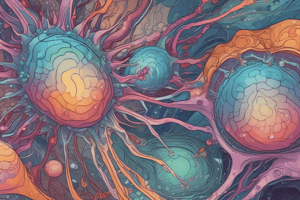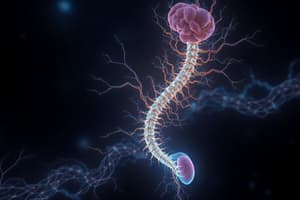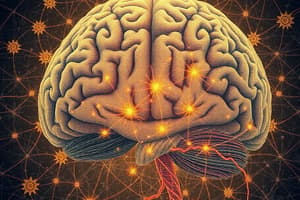Podcast
Questions and Answers
What is the primary structure that forms the basis of the brain and spinal cord during neurulation?
What is the primary structure that forms the basis of the brain and spinal cord during neurulation?
The neural tube forms the basis of the brain and spinal cord.
At what rate are neurons added during early embryonic life?
At what rate are neurons added during early embryonic life?
Neurons are added at a rate of 250,000 neurons per minute.
During which stage of neurodevelopment do progenitor cells primarily undergo mitosis?
During which stage of neurodevelopment do progenitor cells primarily undergo mitosis?
During neurogenesis, progenitor cells divide primarily through mitosis.
What happens to the neural tube during the third week of embryonic life?
What happens to the neural tube during the third week of embryonic life?
What average number of other cells does a single neuron interact with?
What average number of other cells does a single neuron interact with?
What is the peak period for neural migration during brain development?
What is the peak period for neural migration during brain development?
How are newly-formed neurons guided into position during neural migration?
How are newly-formed neurons guided into position during neural migration?
What happens to the migration of neurons after the peak period?
What happens to the migration of neurons after the peak period?
What occurs after immature neurons reach their positions?
What occurs after immature neurons reach their positions?
What is the significance of the laminar structure formed in the cortex?
What is the significance of the laminar structure formed in the cortex?
What is the main process of over-production of synapses that occurs mainly postnatally?
What is the main process of over-production of synapses that occurs mainly postnatally?
At what gestational age does myelination typically begin in the visual system?
At what gestational age does myelination typically begin in the visual system?
What process involves the programmed death of neurons that do not establish connections?
What process involves the programmed death of neurons that do not establish connections?
During which developmental stage does synaptic reorganization primarily occur?
During which developmental stage does synaptic reorganization primarily occur?
What type of glial cell is responsible for the production of myelin?
What type of glial cell is responsible for the production of myelin?
Which two processes are involved in the competitive elimination of neurons during neurodevelopment?
Which two processes are involved in the competitive elimination of neurons during neurodevelopment?
What is the significance of dendritic and axonal arborisation during neurodevelopment?
What is the significance of dendritic and axonal arborisation during neurodevelopment?
What stage of brain development follows neurogenesis and is characterized by maximum growth?
What stage of brain development follows neurogenesis and is characterized by maximum growth?
Flashcards
Neurogenesis
Neurogenesis
The process of generating new neurons from progenitor cells.
Neural Migration
Neural Migration
The process of new neurons moving from their birthplace in the neural tube to their final location in the brain.
Neural Differentiation
Neural Differentiation
The process of immature neurons specializing into specific types of neurons, each with a unique function.
Neurulation
Neurulation
Signup and view all the flashcards
Progenitor cells
Progenitor cells
Signup and view all the flashcards
Radial glia cells
Radial glia cells
Signup and view all the flashcards
Traffic windows
Traffic windows
Signup and view all the flashcards
Laminar structure of cortex
Laminar structure of cortex
Signup and view all the flashcards
Synaptogenesis
Synaptogenesis
Signup and view all the flashcards
Apoptosis (cell death)
Apoptosis (cell death)
Signup and view all the flashcards
Synaptic reorganisation
Synaptic reorganisation
Signup and view all the flashcards
Myelination
Myelination
Signup and view all the flashcards
Prenatal development
Prenatal development
Signup and view all the flashcards
Postnatal development
Postnatal development
Signup and view all the flashcards
Maximal Brain Growth
Maximal Brain Growth
Signup and view all the flashcards
Study Notes
Neurodevelopment
- The adult brain contains approximately 80 billion neurons, 15 times more than the global human population.
- During early embryonic development, neurons are generated at a rate of 250,000 per minute.
- Almost all brain structures are present at birth.
- Brain growth reaches roughly 80% of its adult size by age 2.
- A single neuron typically interacts with an average of 15,000 other cells.
Stages of Neurodevelopment
-
Neurogenesis (Mitosis): Stem cells in the neural tube divide through mitosis to create more progenitor cells (early in development; symmetrical cell division). Later progenitor cells divide asymmetrically creating one progenitor cell and one neuron/glial cell. This process is most prominent during weeks 8-16 of development.
-
Neural Migration: Newly formed neurons from the ventricular zone are guided to their correct location by radial glial cells. A wave-like process, with earlier migrating neurons setting the position for later migrations. Brain region development relies on precise spatial relationships among neurons. This is heavy during weeks 8-16 and then slows until around 25 weeks after conception.
-
Neural Differentiation: Immature neurons, once in their proper positions, mature into specific neuron types. This differentiation process leads to the distinctive layers of the cerebral cortex.
-
Synaptogenesis: Overproduction of synapses. Begins around 17 weeks post-conception and mostly occurs after birth. This period is characterized by synapse redundancy.
-
Apoptosis (Cell Death): Neurons whose axons do not find their targets undergo programmed cell death (apoptosis) which is genetically driven -different from necrosis. This process occurs from around 16 weeks post-conception, to after birth.
-
Synapse Rearrangement: Synaptic connections are reorganized and refined, leading to more precise and efficient neuronal circuits. This process extends from approximately 26 weeks after conception until after birth or even into adolescence.
-
Myelination: Oligodendrocytes produce myelin which coats axons. Myelination plays a crucial role in facilitating efficient nerve impulse transmission. It starts in the visual system before birth and extends to other sensory systems. Sensory systems are myelinated earlier than motor systems. All white matter tracts are myelinated by 2 years.
Time Course of Neurodevelopment
-
The images show how neurodevelopment is a protracted process that continues after birth.
-
The stages occur during specific time periods. This is helpful in understanding what may harm a developing fetus.
Summary of Critical Period Stages
- The stages of early brain development are influenced by critical periods. The first 2 weeks of embryonic development, critical periods for creating systems, and for the sensory systems following these critical periods.
- Critical periods are related to neural activity and their relationships, as well as synaptic and/or dendritic connections and arborisations, during specific time periods.
Studying That Suits You
Use AI to generate personalized quizzes and flashcards to suit your learning preferences.




